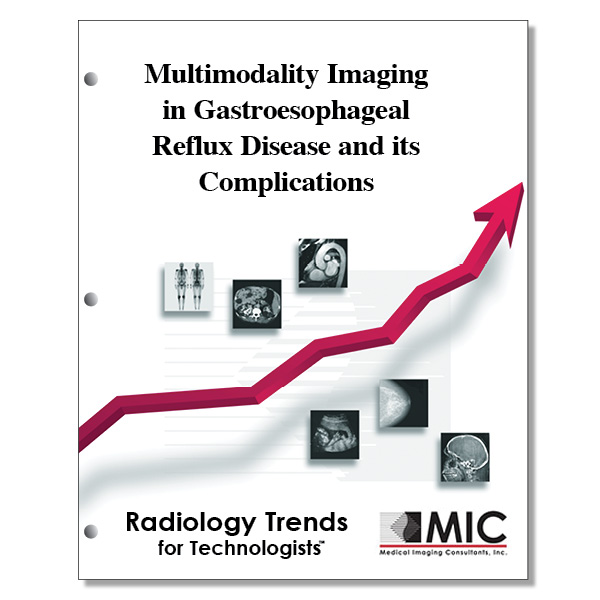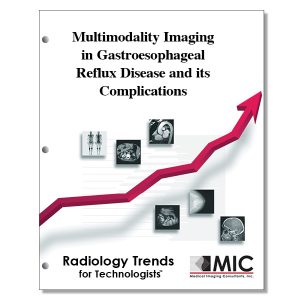

Multimodality Imaging in Gastroesophageal Reflux Disease and its Complications
A comprehensive explanation of the pathophysiology of gastroesophageal reflux disease and its associated complications, to improve detection and interpretation of relevant findings with all modalities.
Course ID: Q00631 Category: Radiology Trends for Technologists Modalities: CT, MRI, Nuclear Medicine, Radiography, Sonography3.0 |
Satisfaction Guarantee |
$34.00
- Targeted CE
- Outline
- Objectives
Targeted CE per ARRT’s Discipline, Category, and Subcategory classification:
[Note: Discipline-specific Targeted CE credits may be less than the total Category A credits approved for this course.]
Computed Tomography: 1.50
Procedures: 1.50
Abdomen and Pelvis: 1.50
Magnetic Resonance Imaging: 1.50
Procedures: 1.50
Body: 1.50
Nuclear Medicine Technology: 0.75
Procedures: 0.75
Endocrine and Oncology Procedures: 0.25
Gastrointestinal and Genitourinary Procedures: 0.50
Radiography: 2.00
Procedures: 2.00
Thorax and Abdomen Procedures: 2.00
Registered Radiologist Assistant: 2.75
Patient Care: 0.25
Pharmacology: 0.25
Procedures: 2.50
Abdominal Section: 2.50
Radiation Therapy: 0.50
Procedures: 0.50
Treatment Sites and Tumors: 0.50
Outline
- Introduction
- Normal Esophagus and Esophagogastric Junction
- Gastroesophageal Reflux Disease
- Definition and Classification
- Clinical Manifestation
- Pathophysiology
- Diagnosis
- Treatment
- Complications of GERD
- Reflux Esophagitis
- Definition and Pathophysiology
- Pathologic Features
- Imaging Features
- Treatment
- Peptic Stricture
- Definition and Pathophysiology
- Pathologic Features
- Imaging Features
- Treatment
- Barrett Esophagus
- Definition and Pathophysiology
- Pathologic Features
- Imaging Features
- Treatment
- Esophageal Adenocarcinoma
- Definition and Pathophysiology
- Pathologic Features
- Imaging Features
- Endoscopy
- Fluoroscopy
- Computed Tomography
- Positron Emission Tomography
- MR Imaging
- Treatment
- Reflux Esophagitis
- Conclusion
Objectives
Upon completion of this course, students will:
- state the estimated number of adults in the Western world that experience reflux symptoms
- identify the epidemic that is believed to be responsible for the high prevalence of GERD in the United States
- choose the primary imaging modality for the evaluation of the esophagus
- list the factors that have resulted in barium studies being performed by fewer senior radiologists
- describe how esophageal luminal distention with effervescents is beneficial
- illustrate how the esophagus connects to the stomach
- list the segments of the esophagus
- choose the segment of the esophagus that is usually less than 3cm long
- list the layers of the esophagus
- state the junction that demarcates the transition from the esophagus to the stomach
- describe how lower esophageal sphincter relaxation occurs
- state the percent of GERD patients in the United States
- list the characteristic symptoms of GERD
- list the extraesophageal symptoms associated with GERD
- describe the causes of lower esophageal sphincter failure
- state the percent of GERD patients that have defective lower esophageal sphincters
- state how high-resolution endoscopy provides exceptional mucosal detail
- list the benefits of fluoroscopic esophagography
- describe high-volume reflux
- compare barium studies to endoscopy as related to accurately depicting hiatal hernias
- list the imaging modalities that may help serve in the diagnosis of GERD
- differentiate between nonpharmacologic and pharmacologic treatment for GERD
- list the minimally invasive laparoscopic and endoscopic luminal treatments for GERD
- state the earliest and most common manifestation of injury due to gastroesophageal reflux
- describe regenerative changes associated with pathology of reflux esophagitis
- describe how the severity of erosive reflux esophagitis is graded
- state the most common cause of ulcers in the distal esophagus
- recall the percent of patients that have had healing of erosive esophagitis based on a primary treatment algorithm
- provide the alternate name for reflux-induced strictures
- list the percent of GERD patients that have peptic ulcers
- state the sensitivity of biphasic esophagography in the detection of peptic stricture
- describe intramural pseudodiverticulosis
- list treatment options for refractory strictures
- state the most important determinant for the development of Barrett’s esophagus
- describe long-segment Barrett’s esophagus
- state the classic finding for Barrett’s esophagus at esophagography
- recall the worldwide percentage of esophageal cancer
- state the role of multimodality imaging in the detection of esophageal adenocarcinoma
- describe the process of esophageal adenocarcinoma tumor staging
- state the percent of patients with esophageal adenocarcinoma that experience lymphadenopathy
